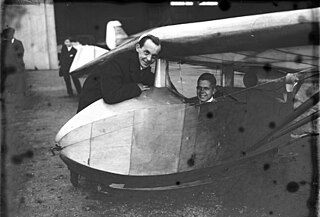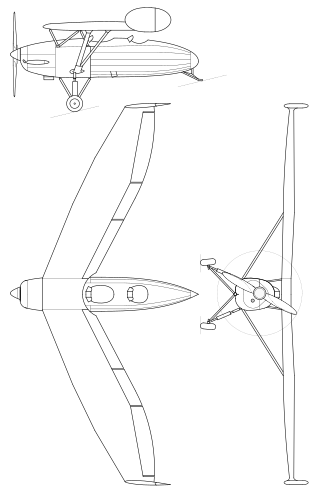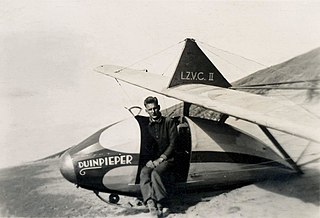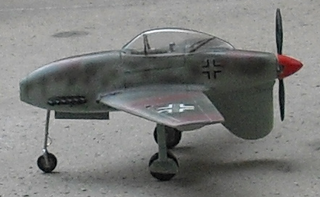
The Messerschmitt Me 163 Komet is a rocket-powered interceptor aircraft primarily designed and produced by the German aircraft manufacturer Messerschmitt. It is the only operational rocket-powered fighter aircraft in history as well as the first piloted aircraft of any type to exceed 1,000 kilometres per hour (620 mph) in level flight.

A delta wing is a wing shaped in the form of a triangle. It is named for its similarity in shape to the Greek uppercase letter delta (Δ).

Alexander Martin Lippisch was a German aeronautical engineer, a pioneer of aerodynamics who made important contributions to the understanding of tailless aircraft, delta wings and the ground effect, and also worked in the U.S. Within the Opel-RAK program, he was the designer of the world's first rocket-powered glider.

The DFS 194 was a rocket-powered aircraft designed by Alexander Lippisch at the Deutsche Forschungsanstalt für Segelflug.

Alexander Lippisch's Delta IV was a continuation of his work on delta wing designs pioneered in his Delta I, Delta II and Delta III aircraft.

The Northrop X-4 Bantam was a prototype small twinjet aircraft manufactured by Northrop Corporation in 1948. It had no horizontal tail surfaces, depending instead on combined elevator and aileron control surfaces for control in pitch and roll attitudes, almost exactly in the manner of the similar-format, rocket-powered Messerschmitt Me 163 of Nazi Germany's Luftwaffe. Some aerodynamicists had proposed that eliminating the horizontal tail would also do away with stability problems at fast speeds resulting from the interaction of supersonic shock waves from the wings and the horizontal stabilizers. The idea had merit, but the flight control systems of that time prevented the X-4 from achieving any success.

The Lippisch P.12, P.13a and P.13b were related design projects for a ramjet-powered delta wing interceptor aircraft studied in 1944 by German designer Alexander Lippisch. The P.12 and P.13a were unarmed, relying on reinforced wings to ram its opponent. The P.13a and b were to be powered by producer gas made in-flight from powdered coal. The DM-1 was a full-size glider, flown to test the P.12/13a low-speed aerodynamics. The design series were unrelated to the earlier P.13 produced by Messerschmitt's Lippisch design office.

The de Havilland DH 108 "Swallow" was a British experimental aircraft designed by John Carver Meadows Frost in October 1945. The DH 108 featured a tailless, swept wing with a single vertical stabilizer, similar to the layout of the wartime German Messerschmitt Me 163 Komet. Initially designed to evaluate swept wing handling characteristics at low and high subsonic speeds for the proposed early tailless design of the Comet airliner, three examples of the DH 108 were built to Air Ministry specifications E.18/45. With the adoption of a conventional tail for the Comet, the aircraft were used instead to investigate swept wing handling up to supersonic speeds. All three prototypes were lost in fatal crashes.

In aeronautics, a tailless aircraft is an aircraft with no other horizontal aerodynamic surface besides its main wing. It may still have a fuselage, vertical tail fin, and/or vertical rudder.

The DFS 193 was a planned experimental German aircraft of the 1930s planned by Deutsche Forschungsanstalt für Segelflug (DFS). Designed by Professor Alexander Lippisch and a DFS employee named Roth, it resembled Lippisch's Storch IX and the Gotha Go 147.

The Zögling is a German high-wing, cable-braced, single seat primary glider that was designed by Alexander Lippisch in 1926 and produced with many variations by a variety of manufacturers.

The RRG Fafnir 2 São Paulo, named after the legendary dragon and the Brazilian city which partially financed it, was a single seat German high performance glider designed by Alexander Lippisch. It set a new world distance record in 1934 and won the 1937 International Gliding Championships.

The Messerschmitt Me 334 was a proposed German piston-engined fighter, designed by Alexander Lippisch. No examples were built.

The RRG Storch V was the only member of Alexander Lippisch's Storch series of tailless aircraft to be powered. It flew successfully in the year 1929.

The Kharkiv KhAI-4 was an experimental Soviet tailless aircraft tested in 1934. It only made three flights before being grounded as dangerous.
The RRG Delta I was a German experimental tailless aircraft flown in the early 1930s first as a glider and then powered. It was one of the first delta wing aircraft.

The Fieseler F 3 Wespe ("Wasp") was a German aircraft designed by Alexander Lippisch as the Delta IV and built by Fieseler. Lippisch later redesignated its variants as the Delta IVa and b, with the c variant being built as the DFS 39.
The Lippisch Delta VI was a proposed single-seat, twin-jet experimental delta flying wing aircraft begun in 1943 by German designer Alexander Lippisch, as the developed version of the P.11 bomber project begun while he was still working for Messerschmitt in 1942. The only prototype was destroyed in June 1944 while still under construction.















